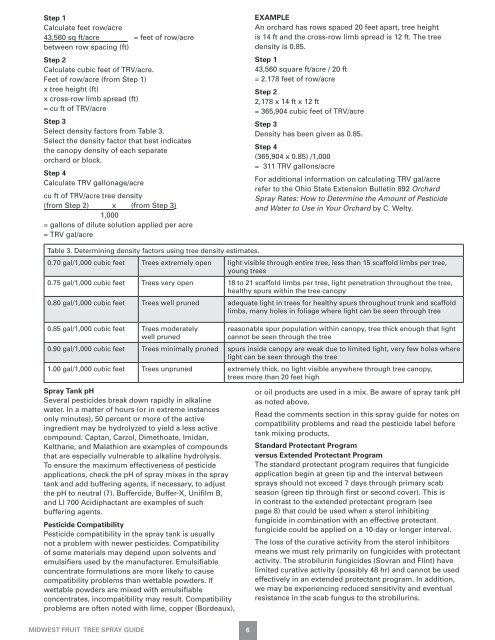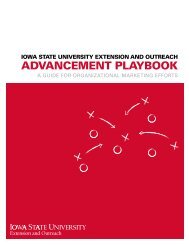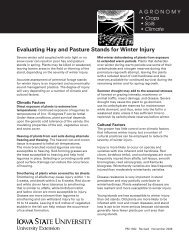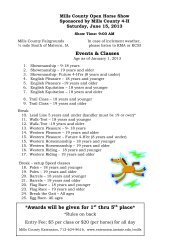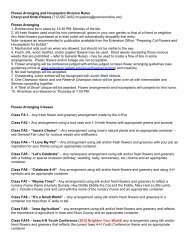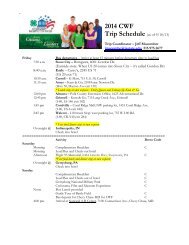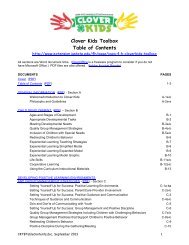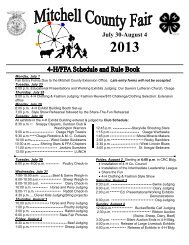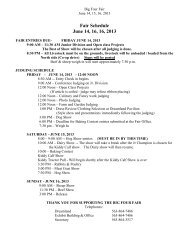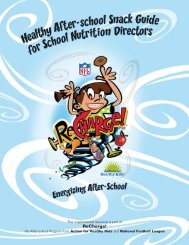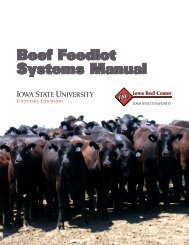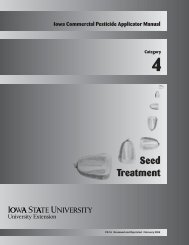Midwest Tree Fruit Spray Guide - Iowa State University Extension ...
Midwest Tree Fruit Spray Guide - Iowa State University Extension ...
Midwest Tree Fruit Spray Guide - Iowa State University Extension ...
Create successful ePaper yourself
Turn your PDF publications into a flip-book with our unique Google optimized e-Paper software.
Step 1<br />
Calculate feet row/acre<br />
43,560 sq ft/acre = feet of row/acre<br />
between row spacing (ft)<br />
Step 2<br />
Calculate cubic feet of TRV/acre.<br />
Feet of row/acre (from Step 1)<br />
x tree height (ft)<br />
x cross-row limb spread (ft)<br />
= cu ft of TRV/acre<br />
Step 3<br />
Select density factors from Table 3.<br />
Select the density factor that best indicates<br />
the canopy density of each separate<br />
orchard or block.<br />
Step 4<br />
Calculate TRV gallonage/acre<br />
cu ft of TRV/acre tree density<br />
(from Step 2) x (from Step 3)<br />
1,000<br />
= gallons of dilute solution applied per acre<br />
= TRV gal/acre<br />
Table 3. Determining density factors using tree density estimates.<br />
0.70 gal/1,000 cubic feet <strong>Tree</strong>s extremely open light visible through entire tree, less than 15 scaffold limbs per tree,<br />
young trees<br />
0.75 gal/1,000 cubic feet <strong>Tree</strong>s very open 18 to 21 scaffold limbs per tree, light penetration throughout the tree,<br />
healthy spurs within the tree canopy<br />
0.80 gal/1,000 cubic feet <strong>Tree</strong>s well pruned adequate light in trees for healthy spurs throughout trunk and scaffold<br />
limbs, many holes in foliage where light can be seen through tree<br />
0.85 gal/1,000 cubic feet <strong>Tree</strong>s moderately<br />
well pruned<br />
MIDWEST FRUIT TREE SPRAY GUIDE<br />
6<br />
EXAMPLE<br />
An orchard has rows spaced 20 feet apart, tree height<br />
is 14 ft and the cross-row limb spread is 12 ft. The tree<br />
density is 0.85.<br />
Step 1<br />
43,560 square ft/acre / 20 ft<br />
= 2.178 feet of row/acre<br />
Step 2<br />
2,178 x 14 ft x 12 ft<br />
= 365,904 cubic feet of TRV/acre<br />
Step 3<br />
Density has been given as 0.85.<br />
Step 4<br />
(365,904 x 0.85) /1,000<br />
= 311 TRV gallons/acre<br />
For additional information on calculating TRV gal/acre<br />
refer to the Ohio <strong>State</strong> <strong>Extension</strong> Bulletin 892 Orchard<br />
<strong>Spray</strong> Rates: How to Determine the Amount of Pesticide<br />
and Water to Use in Your Orchard by C. Welty.<br />
reasonable spur population within canopy, tree thick enough that light<br />
cannot be seen through the tree<br />
0.90 gal/1,000 cubic feet <strong>Tree</strong>s minimally pruned spurs inside canopy are weak due to limited light, very few holes where<br />
light can be seen through the tree<br />
1.00 gal/1,000 cubic feet <strong>Tree</strong>s unpruned extremely thick, no light visible anywhere through tree canopy,<br />
trees more than 20 feet high<br />
<strong>Spray</strong> Tank pH<br />
Several pesticides break down rapidly in alkaline<br />
water. In a matter of hours (or in extreme instances<br />
only minutes), 50 percent or more of the active<br />
ingredient may be hydrolyzed to yield a less active<br />
compound. Captan, Carzol, Dimethoate, Imidan,<br />
Kelthane, and Malathion are examples of compounds<br />
that are especially vulnerable to alkaline hydrolysis.<br />
To ensure the maximum effectiveness of pesticide<br />
applications, check the pH of spray mixes in the spray<br />
tank and add buffering agents, if necessary, to adjust<br />
the pH to neutral (7). Buffercide, Buffer-X, Unifilm B,<br />
and LI 700 Acidiphactant are examples of such<br />
buffering agents.<br />
Pesticide Compatibility<br />
Pesticide compatibility in the spray tank is usually<br />
not a problem with newer pesticides. Compatibility<br />
of some materials may depend upon solvents and<br />
emulsifiers used by the manufacturer. Emulsifiable<br />
concentrate formulations are more likely to cause<br />
compatibility problems than wettable powders. If<br />
wettable powders are mixed with emulsifiable<br />
concentrates, incompatibility may result. Compatibility<br />
problems are often noted with lime, copper (Bordeaux),<br />
or oil products are used in a mix. Be aware of spray tank pH<br />
as noted above.<br />
Read the comments section in this spray guide for notes on<br />
compatibility problems and read the pesticide label before<br />
tank mixing products.<br />
Standard Protectant Program<br />
versus Extended Protectant Program<br />
The standard protectant program requires that fungicide<br />
application begin at green tip and the interval between<br />
sprays should not exceed 7 days through primary scab<br />
season (green tip through first or second cover). This is<br />
in contrast to the extended protectant program (see<br />
page 8) that could be used when a sterol inhibiting<br />
fungicide in combination with an effective protectant<br />
fungicide could be applied on a 10-day or longer interval.<br />
The loss of the curative activity from the sterol inhibitors<br />
means we must rely primarily on fungicides with protectant<br />
activity. The strobilurin fungicides (Sovran and Flint) have<br />
limited curative activity (possibly 48 hr) and cannot be used<br />
effectively in an extended protectant program. In addition,<br />
we may be experiencing reduced sensitivity and eventual<br />
resistance in the scab fungus to the strobilurins.


